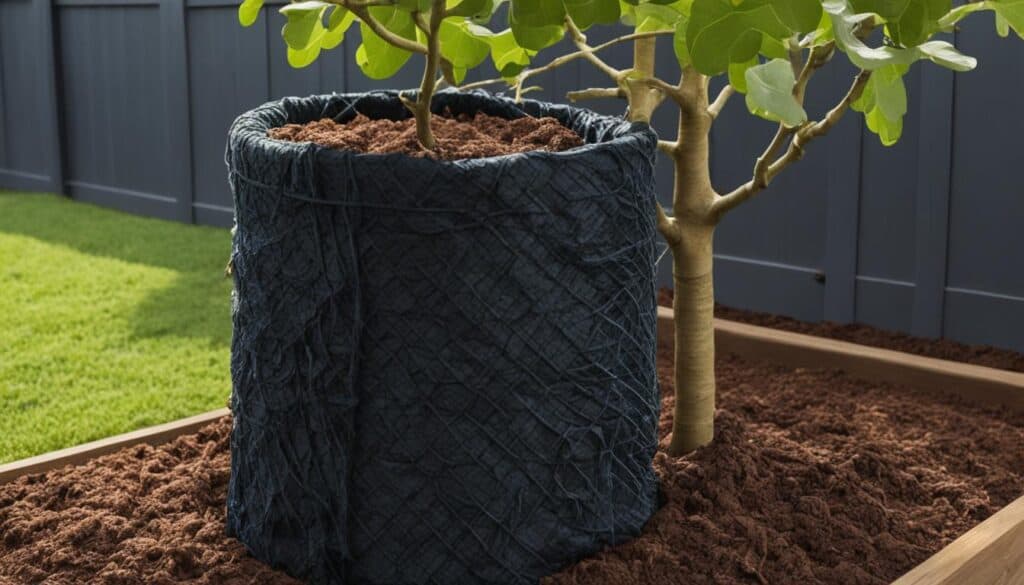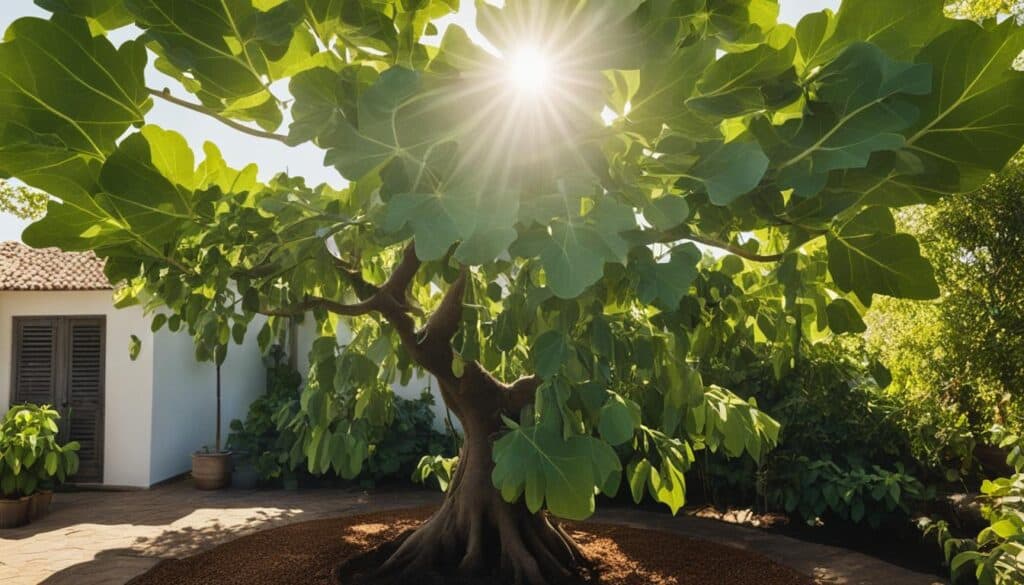Growing a fig tree can be an exciting and rewarding experience. However, it can be disheartening when your fig tree fails to produce any fruit. If you find yourself wondering why your fig tree has no fruit, there are several factors that could be contributing to this issue. In this article, I will explore some common reasons why fig trees may not be producing fruit and provide you with actionable tips to encourage fruit production.
Key Takeaways:
- A lack of sunlight, unhealthy soil, and hormonal imbalances can lead to a fig tree not bearing fruit.
- Differentiate between a fig tree not forming figs and experiencing premature fruit drop.
- Fig trees can start producing fruit at a young age but may vary based on the variety.
- Sunlight is crucial for fig trees to produce fruit, so ensure they receive adequate sunlight.
- Proper pruning techniques and maintaining a healthy tree can enhance fruit production.
Understanding the Problem: Figs Not Forming vs. Figs Dropping
When it comes to fig trees, the absence of fruit can be a source of frustration for many gardeners and enthusiasts. However, it’s crucial to distinguish between two common issues: fig trees not forming figs and fig trees experiencing premature fruit drop. In this section, we’ll focus on the former, specifically addressing trees that exhibit abundant leaf growth but fail to produce figs.
This perplexing situation is a common challenge faced by fig growers. You may have noticed that your fig tree is flourishing in terms of foliage, yet it remains barren when it comes to fig production. Understanding the underlying reasons behind this phenomenon is key to resolving the issue and enjoying the satisfying experience of harvesting your own homegrown figs.
“The fig tree that stands tall, with lush leaves aplenty, but no fruits to show, can certainly leave one perplexed.”
Unveiling the secrets behind this ‘fig mystery’ requires a closer look at the intricacies of the tree’s reproductive process. While fig trees possess separate male (staminate) and female (pistillate) flowers, cultivating figs relies on a unique pollination process facilitated by specialized fig wasps. However, even in the absence of these wasps, some fig varieties possess the ability to self-pollinate. So, why then do some fig trees fail to bear fruit?
One possible explanation is that the tree is simply too young. Fig trees can take time to reach maturity and establish their fruit-bearing capacity. While certain cultivars may yield fruit as early as six months from cutting, others may require a longer gestation period.
It’s also worth considering the role of environmental factors. Insufficient sunlight can impede the development of main crop fruit buds, resulting in a lack of fig production. Additionally, hormonal imbalances, poor soil conditions, or the Fig Mosaic Virus can further exacerbate the issue of unfruitful fig trees.
By delving into the root causes behind the lack of fig formation, we can unravel the mysteries and unlock the potential of our fig trees. In the next sections, we’ll explore various strategies and techniques that can help address these concerns and set the stage for a bountiful harvest of sweet, succulent figs.
Stay tuned for insights on:
- The impact of fig tree age on fruit production
- The crucial role of sunlight for fig tree health and fruiting
- Pruning techniques to encourage fig tree fruit production
- Essential practices for maintaining a healthy fig tree
- The influence of metabolism and temperature on fig tree fruiting
- Other factors affecting fig tree fruit production
Fig Tree’s Age and Fruit Production
One of the key factors that can affect a fig tree’s ability to bear fruit is its age. While fig trees can start producing fruit at a young age, the exact timeline can vary depending on the variety. In some cases, a fig tree may produce fruit as early as 6 months from cutting, while others may take a few years to reach maturity.
It’s important to understand that young fig trees prioritize leaf and shoot growth over fruit production. This means that even if your tree appears healthy and vibrant, it may not be ready to produce figs yet. Patience is crucial when it comes to fig tree fruit production.
Giving your fig tree time to reach the appropriate maturity level is essential. As the tree matures, it gradually shifts its energy towards fruit production. This process can take several years, but it ultimately leads to the development of abundant and delicious figs.
So, if your fig tree is not bearing fruit because of its age, remain patient and continue providing it with the proper care and conditions it needs to thrive.
Factors Affecting Fig Tree’s Fruit Production
Age is just one of the many factors that can influence a fig tree’s fruit production. Other important considerations include sunlight, pruning techniques, tree health, nutrient balance, and watering conditions. By understanding and addressing these various factors, you can increase the likelihood of your fig tree bearing an abundant harvest of tasty figs.
| Factors Affecting Fig Tree Fruit Production | Description |
|---|---|
| Sunlight | Fig trees require a certain amount of sunlight to produce fruit. Lack of sunlight can hinder fruit development. |
| Pruning Techniques | Proper pruning can promote fruit production by maximizing sunlight penetration and airflow within the tree. |
| Tree Health | A healthy fig tree is more likely to bear fruit consistently. Factors such as soil health, moisture, and disease prevention play a role. |
| Nutrient Balance | The right balance of nutrients, including nitrogen, phosphorus, and potassium, is crucial for fig tree fruit production. |
| Watering Conditions | Providing adequate moisture while avoiding water stress is important for supporting fig tree fruit development. |
By addressing these factors and providing proper care, you can create an environment that encourages your fig tree to thrive and produce delicious, bountiful figs.
The Importance of Sunlight for Fig Trees
Sunlight plays a critical role in the fruit production of fig trees. It is an essential factor that directly affects the formation of main crop fruit buds on the tree. Understanding the specific light requirements of your fig tree variety is key to ensuring optimal fruit production.
Different fig tree varieties have varying needs when it comes to the intensity and duration of sunlight. While some varieties thrive in full sunlight, others may require partial shade. Therefore, it is crucial to know the specific light requirements of your fig tree to provide the ideal conditions for fruiting.
To maximize fruit production on your fig tree, here are some important considerations:
- Choose the right location: Select a spot in your garden or yard that receives abundant sunlight throughout the day. Ensure that there are no obstructions such as buildings, fences, or trees that may shade the fig tree.
- Prune for better light penetration: Regularly prune your fig tree to remove crowded or overlapping branches. This opens up the canopy, allowing more sunlight to reach the inner parts of the tree. Proper pruning helps to create a well-ventilated and well-illuminated environment for fruit production.
- Consider reflective surfaces: Placing reflective surfaces, such as white or light-colored boards or walls, near your fig tree can help redirect and amplify sunlight. This can be particularly beneficial if your fig tree is positioned in a partially shaded area.
Remember, providing your fig tree with the correct amount of sunlight is essential to encourage fruit production. By meeting its light requirements, you can increase the chances of your fig tree bearing a bountiful harvest of delicious figs.
| Fig Tree Variety | Light Requirement |
|---|---|
| Brown Turkey | Full Sun |
| Black Jack | Full to Partial Sun |
| Chicago Hardy | Full to Partial Sun |
Pruning Techniques for Improved Fruit Production
Proper pruning is a key practice in promoting the growth and fruit production of fig trees. By employing effective pruning techniques, you can encourage your fig tree to produce an abundance of delicious figs. Pruning serves multiple purposes, including increasing sunlight penetration, opening up the center of the tree, and removing unhealthy or damaged branches.
One of the primary goals of pruning is to allow more sunlight to reach the inner branches and leaves of the fig tree. Sunlight plays a crucial role in the photosynthesis process, which is essential for plant growth and fruit production. Pruning can help remove excessive foliage and branches that may be blocking sunlight from reaching the lower parts of the tree.
Another benefit of pruning is improving the airflow within the tree. Proper airflow reduces the risk of disease and pest infestations, creating a healthier and more productive fig tree. By selectively removing branches, you can open up the center of the tree, allowing better air circulation and sunlight exposure to the figs.
When pruning fig trees, it’s important to remove any unhealthy or damaged branches. These branches can serve as entry points for pests and diseases, potentially compromising the overall health of the tree. By removing them, you can prevent the spread of pathogens and ensure the tree’s resources are focused on fruit production.
Pruning should be done during the dormant season, typically in late winter or early spring, before new growth begins. It’s essential to use clean and sharp pruning tools to avoid damaging the tree further. The correct pruning cuts should be made just above a bud or lateral branch to promote healthy regrowth.
Proper pruning techniques can enhance the growth and fruit production of fig trees, creating a more bountiful harvest of delicious figs.
Remember, every fig tree is unique, and pruning techniques may vary depending on the specific variety and growth pattern. It’s always advisable to consult a local horticulturist or arborist for guidance tailored to your fig tree’s needs.
Pruning Tips for Fig Trees
- Remove any dead, damaged, or diseased branches.
- Thin out dense foliage to improve sunlight penetration.
- Open up the center of the tree by selectively removing branches.
- Prune back any branches that are touching or crossing each other.
- Trim back excessively long branches to maintain a balanced tree shape.
| Benefits of Pruning |
|---|
| Increased sunlight penetration |
| Improved air circulation |
| Reduced risk of disease and pest infestations |
| Removal of unhealthy or damaged branches |
Maintaining a Healthy Fig Tree for Fruit Production
A healthy fig tree is vital for consistent fruit production. Several factors contribute to the overall health of the tree, including soil quality, moisture levels, nutrient balance, and microbe activity. Additionally, the presence of Fig Mosaic Virus can significantly impact the growth and fruit production of fig trees.
To ensure the health of your fig tree, it’s essential to follow these steps:
1. Soil Management
Proper soil management is crucial for a healthy fig tree. Ensure that the soil is well-drained and rich in organic matter. Conduct soil testing to identify any nutrient deficiencies or imbalances that may impede fruit production. Based on the test results, amend the soil with the appropriate fertilizers or organic matter to create optimal growing conditions for the tree.
2. Moisture Levels
Fig trees require consistent moisture to thrive. Adequate irrigation is essential, especially during dry periods or drought. Monitor the moisture levels in the soil and adjust watering accordingly. Avoid overwatering, as it can lead to root rot, but also prevent water stress by ensuring the tree receives sufficient moisture to support its fruit-bearing capacity.
3. Nutrient Balance
Providing the right balance of nutrients is crucial for fig tree health and fruit production. Use a balanced fertilizer specifically formulated for fruit trees, ensuring that nitrogen levels are not excessive. Too much nitrogen can promote excessive leaf growth at the expense of fruit production. Consider supplementing with phosphorus to counteract excessive nitrogen and promote fruiting.
4. Microbe Activity
The presence of beneficial microbes in the soil can enhance the overall health of the fig tree. Encourage microbial activity by incorporating homemade compost tea into the soil. Compost tea provides beneficial microorganisms that aid in nutrient absorption and promote healthy root development, ultimately boosting fruit production.

“Maintaining a healthy fig tree is the foundation for a fruitful harvest. By implementing proper soil management practices, ensuring optimal moisture levels, balancing nutrients, and promoting beneficial microbe activity, you can significantly enhance the health and fruit production of your fig tree.”
The Role of Metabolism and Temperature
Metabolism plays a vital role in the fruit production of fig trees. The metabolic rate of a fig tree is greatly influenced by the temperature of the soil and its surrounding environment. To ensure optimal fruit production, it’s important to understand the ideal temperature conditions for fig trees.
Fig trees thrive in warm climates with temperatures ranging from 70°F to 85°F (21°C to 29°C). These temperature ranges provide the right conditions for the tree’s metabolic processes to function efficiently, leading to healthier fruit production.
However, figs may struggle to ripen properly if the soil temperature drops too low. If you live in an area with colder climates, you can take steps to increase the soil temperature and boost the tree’s metabolism. One effective method is to use black plastic pots or raised beds. The dark color of the plastic absorbs and retains heat, helping to warm the soil.
Methods for Increasing Soil Temperature
- Use black plastic pots: Planting your fig tree in a black plastic pot can help to increase the soil temperature. The dark color absorbs heat, providing a warmer environment for the tree’s roots.
- Create raised beds: Constructing raised beds for your fig tree ensures better soil drainage and allows for increased sun exposure. The elevation of the beds helps to raise the soil temperature, aiding in the tree’s metabolism.
- Utilize mulch: Applying a layer of organic mulch around the base of the fig tree helps to insulate the soil and regulate its temperature. This can promote optimal metabolic activity.
By implementing these methods, you can create the ideal temperature conditions for your fig tree, enhancing its metabolism and ultimately improving fruit production.

| Temperature Range (°F) | Temperature Range (°C) | Metabolic Activity | Fruit Production |
|---|---|---|---|
| Below 60°F | Below 15°C | Slowed down | May be limited or delayed |
| 60°F to 70°F | 15°C to 21°C | Moderate | Fruit production may be average |
| 70°F to 85°F | 21°C to 29°C | Optimal | Healthy fruit production |
| Above 85°F | Above 29°C | Increased | Fruit production may decrease due to stress |
Additional Factors Affecting Fig Tree Fruit Production
While there are several common factors that can contribute to a fig tree not bearing fruit, such as a lack of sunlight and unhealthy soil, there are other lesser-known factors that can also affect fruit production. It’s important to consider these additional factors if your fig tree is healthy but still not producing figs.
Fertilization Habits
Over-fertilization can actually inhibit fig tree fruiting. When too much nitrogen is applied, the tree may prioritize leaf and branch growth over fruit production. It’s crucial to find the right balance of nutrients for your fig tree, using a balanced fertilizer with lower nitrogen levels or adding phosphorus to counteract the excess nitrogen.
Weather Conditions
Fig trees thrive in warm and sunny climates, but hot and dry weather conditions can negatively impact fruit production. In extreme heat, the tree may focus its energy on survival rather than fruiting. Adequate watering and providing shade during intense heat can help mitigate this issue and increase the likelihood of fruit production.
Root-Knot Nematodes
Root-knot nematodes are microscopic worms that can infect the roots of fig trees. These pests can weaken the tree, affecting its overall health and reducing fruit production. If you suspect the presence of root-knot nematodes, it’s essential to take appropriate measures, such as using nematode-resistant varieties or implementing organic pest control methods.
To summarize, if your fig tree is not bearing fruit despite being in good health, make sure to consider these additional factors such as over-fertilization, dry and hot weather conditions, and the presence of root-knot nematodes. By addressing these issues and taking appropriate measures, you can enhance the fruiting capacity of your fig tree and enjoy a bountiful harvest.

| Factors Affecting Fig Tree Fruit Production | Description |
|---|---|
| Over-fertilization | Excessive nitrogen levels can hinder fruit production in fig trees. |
| Weather Conditions | Dry and hot weather can negatively impact fruit production. |
| Root-Knot Nematodes | Presence of these pests can weaken the tree and reduce fruit production. |
Fig Tree’s Age and Fruit Production
The maturity of a fig tree plays a crucial role in its ability to produce fruit. It’s not uncommon for young fig trees to prioritize leaf and shoot growth over fruit production. As the tree matures, however, it gradually redirects its energy towards bearing fruit. This process can take several years, so patience is key when it comes to waiting for your fig tree to reach its full potential.
During the early stages of growth, young fig trees focus on establishing a strong root system and developing robust branches and foliage. This growth phase is essential for the long-term health and productivity of the tree. While it can be disheartening to see a fig tree without fruit, it’s important to remember that this is a natural part of the tree’s development.
As the fig tree ages, it undergoes physiological changes that enable it to produce an abundance of delicious figs. With time, the tree’s reproductive system matures, and it becomes more efficient at allocating resources towards fruit development. The exact timeline for fruit production can vary depending on the specific variety of fig tree, environmental conditions, and cultural practices.
Patience is key when it comes to fig tree fruit production. Remember that good things come to those who wait, and your patience will eventually be rewarded with a bountiful harvest.
While waiting for your fig tree to mature, there are steps you can take to ensure its overall health and readiness for fruit production. Providing the tree with proper care and maintenance, including appropriate pruning techniques, adequate sunlight exposure, and optimal soil conditions, can help accelerate its transition from a growth-focused state to fruit-bearing maturity.

As your fig tree continues to age and develop, keep in mind that it will gradually become more productive in terms of fruit production. By understanding the natural growth cycle of fig trees and providing them with the necessary care, you can create an environment that encourages fruitful yields year after year.
Nitrogen and its Impact on Fig Tree Fruit Production
When it comes to growing fig trees, nutrition is key. While nitrogen is an essential nutrient for plant growth, excessive levels can have a negative impact on fruit production. Too much nitrogen in the soil can result in lush leaf and branch growth, but it can also hinder the formation of figs.
To ensure that your fig tree produces an abundant harvest, it’s important to find the right nutrient balance. Using a balanced fertilizer with lower nitrogen levels can help prevent an overabundance of foliage at the expense of fruit development. Alternatively, you can add phosphorus to the soil to counteract the effects of excessive nitrogen.
By providing your fig tree with the appropriate nutrients, you can encourage healthy and productive fruit production. Remember, finding the right nutrient balance is crucial for ensuring your fig tree produces the delicious figs you’ve been eagerly anticipating.
| Problem | Cause | Solution |
|---|---|---|
| Fig tree not producing figs | Excessive nitrogen in the soil | Use a balanced fertilizer with lower nitrogen levels or add phosphorus to counteract the nitrogen |
Watering Conditions and Fig Tree Fruit Production
Proper watering is essential for ensuring healthy fruit production in your fig tree. Both overwatering and under watering can impact the tree’s ability to bear fruit.
When a fig tree is overwatered, it can go into survival mode, diverting its energy away from fruit production and focusing on staying alive. On the other hand, if the tree is underwatered and experiences water stress, it can also struggle to produce fruit due to a lack of energy and resources.
To support the fruit-bearing capacity of your fig tree, it is important to provide adequate moisture while preventing water stress. When watering your tree, ensure that the soil is consistently moist but not waterlogged.
Here are some key tips for watering your fig tree:
- Water deeply: It is better to water deeply and less frequently rather than frequent shallow watering. Deep watering promotes deep root growth and ensures proper hydration.
- Monitor soil moisture: Check the moisture level of the soil regularly by sticking your finger about an inch into the soil. If it feels dry at that depth, it’s time to water the tree.
- Avoid overwatering: Fig trees prefer well-draining soil, so make sure there is proper drainage. Excess water can lead to root rot and other issues.
- Consider mulching: Applying a layer of organic mulch around the base of the tree can help retain moisture and regulate soil temperature.
By maintaining optimal watering conditions, you can provide your fig tree with the necessary hydration it needs to thrive and produce delicious, juicy figs.
“Proper watering is vital for fig tree fruit production. Both overwatering and under watering can cause the tree to go into survival mode, resulting in a lack of energy for fruit production.”
Example Watering Schedule
| Month | Watering Frequency | Amount of Water |
|---|---|---|
| April | Every 5-7 days | 3-5 gallons |
| May | Every 4-6 days | 5-7 gallons |
| June | Every 3-5 days | 7-10 gallons |
Note: The watering schedule may vary depending on factors such as climate, soil type, and the age of your fig tree. Adjust the frequency and amount of water accordingly to meet the specific needs of your tree.
Image: A healthy fig tree displaying ample fruit due to proper watering conditions.
Conclusion
Producing fruit on fig trees requires attention to various factors such as sunlight, pruning, tree health, age, and nutrient balance. By understanding these factors and implementing appropriate strategies, you can increase the chances of your fig tree bearing fruit. With patience and proper care, you can enjoy a bountiful harvest of delicious figs from your tree.
To ensure successful fruit production, make sure your fig tree receives adequate sunlight. Each variety has specific requirements, so it’s important to understand the optimal intensity and duration of sunlight for your specific tree. Pruning your fig tree effectively can also promote its growth and fruit production. Focus on increasing sunlight penetration and removing any unhealthy branches.
Maintaining a healthy fig tree is crucial for consistent fruit production. Pay attention to soil health, moisture levels, and nutrient content. Take proactive measures to prevent or manage issues such as the Fig Mosaic Virus, which can adversely affect fruit production. Optimizing the tree’s metabolism by controlling the soil temperature and providing appropriate water conditions can further enhance fruit production.
Lastly, remember that fig trees take time to mature and prioritize fruit production. It is normal for young trees to focus on leaf and shoot growth before transitioning to fruit production. Be patient and give your fig tree the time it needs to develop fully. With proper care and these tips in mind, you’ll soon be rewarded with abundant figs from your thriving tree.
FAQ
Why is my fig tree not producing fruit?
There are several factors that can contribute to a fig tree not bearing fruit, including a lack of sunlight, unhealthy soil, hormonal imbalances, young age, and Fig Mosaic Virus infection.
What is the difference between figs not forming and figs dropping?
Figs not forming refers to the lack of fruit production on a fig tree, while figs dropping refers to the premature falling off of figs that have already formed. These are two separate issues that can affect fig tree fruit production.
How long does it take for a fig tree to produce fruit?
Fig trees can start producing fruit at a young age, sometimes as early as 6 months from cutting. However, the maturity and fruit-bearing capacity of trees can vary depending on the variety. It’s important to be patient and give your fig tree time to reach the appropriate maturity level.
What is the importance of sunlight for fig trees?
Sunlight is crucial for fig trees to produce fruit. Each variety has specific requirements for the intensity and duration of sunlight. Without sufficient sunlight, main crop fruit buds may not form on the tree, leading to a lack of fig production. It’s essential to ensure that your fig tree is receiving the optimal amount of sunlight it needs.
Are there any pruning techniques that can improve fruit production?
Yes, proper pruning techniques can help promote the growth and fruit production of fig trees. Pruning should focus on increasing sunlight penetration, opening up the center of the tree, and removing any unhealthy or damaged branches. By pruning effectively, you can encourage your fig tree to produce an abundance of delicious figs.
How can I maintain a healthy fig tree for fruit production?
A healthy fig tree is more likely to bear fruit consistently. Soil health, moisture levels, nutrient content, and microbe activity all play a role in the overall health of the tree. Additionally, Fig Mosaic Virus can affect the growth and fruit production of fig trees. Proper soil management, testing, and the use of homemade compost tea can help enhance the health of your fig tree.
What role does metabolism and temperature play in fig tree fruit production?
Metabolism plays a vital role in the fruit production of fig trees. Soil temperature and the overall temperature of the tree’s environment affect its metabolism. Figs may struggle to ripen properly if the soil temperature is too low. Increasing the soil temperature through methods like using black plastic pots or raised beds can help boost the tree’s metabolism.
What are some additional factors that can affect fig tree fruit production?
Other factors that can contribute to a fig tree not bearing fruit include over-fertilization, dry and hot weather conditions, and the presence of root-knot nematodes. These factors should be considered if your fig tree is healthy but still not producing figs.
Does the age of a fig tree affect its fruit production?
Yes, the maturity of a fig tree is a crucial factor in determining its fruit production. Young trees may prioritize leaf and shoot growth over fruit production. As the tree matures, it gradually shifts its energy towards producing fruit, but this process can take several years.
How does nitrogen impact fig tree fruit production?
Excessive nitrogen in the soil can lead to lush leaf and branch growth but hinder fruit production in fig trees. It’s important to use a balanced fertilizer with lower nitrogen levels or add phosphorus to counteract the nitrogen. Finding the right nutrient balance is crucial to encourage fruitful fig production.
What are the watering conditions necessary for fig tree fruit production?
Proper watering is vital for fig tree fruit production. Both overwatering and under watering can cause the tree to go into survival mode, resulting in a lack of energy for fruit production. It’s essential to provide adequate moisture, prevent water stress, and ensure proper drainage to support the tree’s fruit-bearing capacity.
How can I get my fig tree to produce fruit?
Producing fruit on fig trees requires attention to various factors such as sunlight, pruning, tree health, age, and nutrient balance. By understanding these factors and implementing appropriate strategies, you can increase the chances of your fig tree bearing fruit. With patience and proper care, you can enjoy a bountiful harvest of delicious figs from your tree.





Leave a Reply